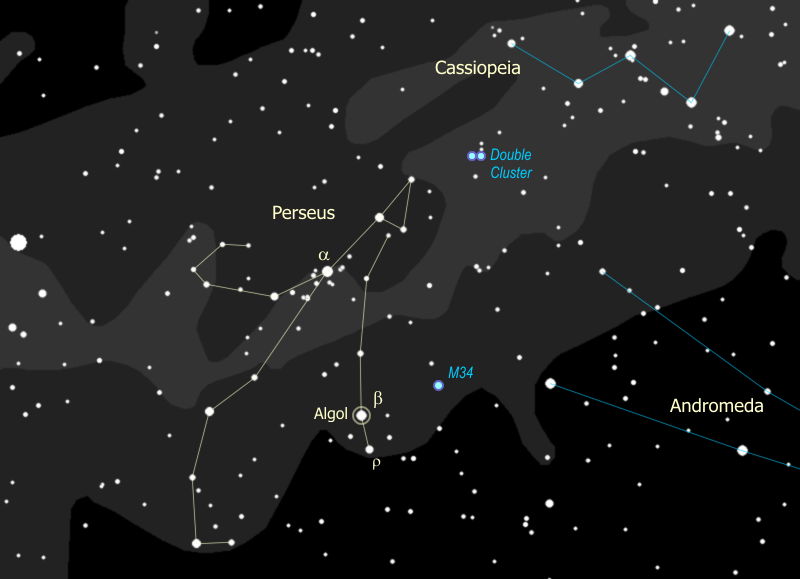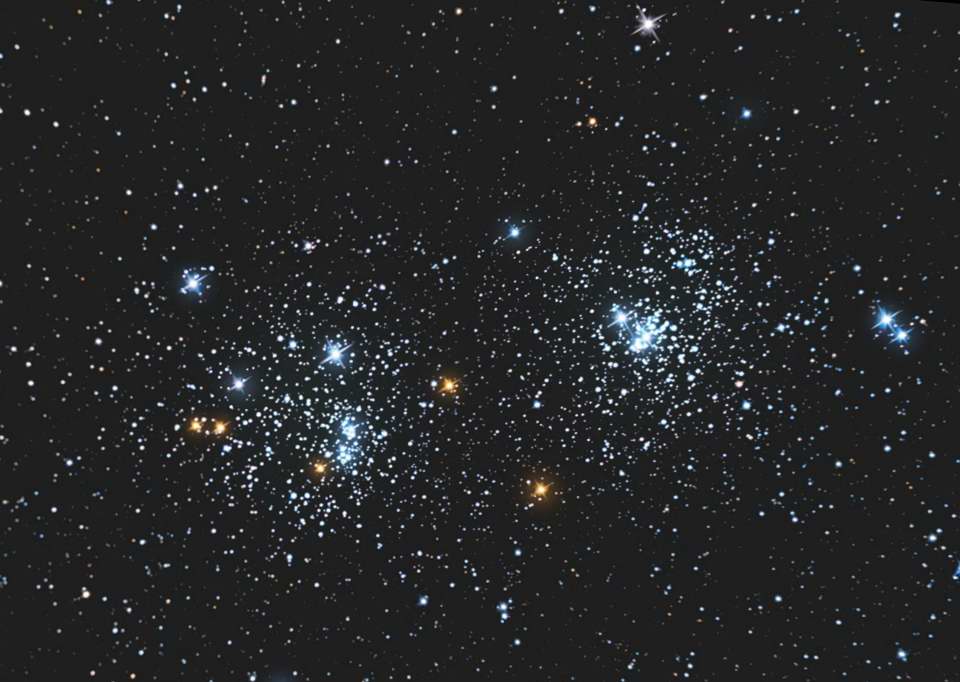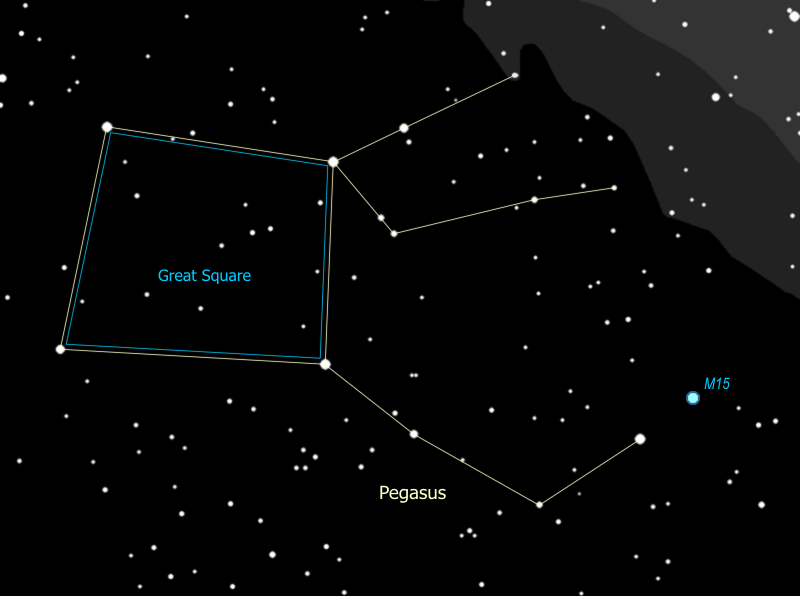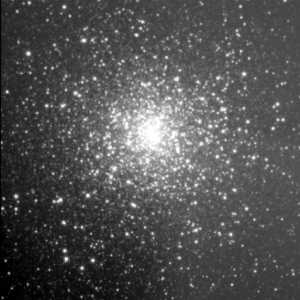Stargazing

|
Perseus the Hero |

|
Ah, here he comes, the guy we've all been waiting for, the hero of our story,
the one, the only -- Perseus!!
- You can find Perseus at Andromeda's feet, and just off the squashed side
of Cassiopeia's "W". The triangle that forms his head, though of modest
brightness, is an easy feature to recognize, then the rest of the figure,
which is pretty bright, is easy to follow from there. {Trace out Perseus}.
His right arm is holding his shield, and in his left hand he has the head
of Medusa the Gorgon. Being a man of action, he comes directly from his
triumphant victory over Medusa and stumbles upon Andromeda, soon to be in
the clutches of Cetus the Seamonster.

- The eye of Medusa is well-represented by the star Algol {point out Algol}.
Since ancient times Algol has been called the "Demon Star", and in fact the
name means "head of the demon". Why? Because this star winks at you.
Since stars aren't supposed to do that, it kind of gave people the willies
long ago, and they figured it had to be evil or posessed or in some other
way just wrong. Normally Algol is nearly as bright as
&alpha Persei {point out &alpha},
almost exactly as bright as γ Andromedae. Sure
enough, just about every 3 days Algol drops in brightness to that of
ρ Persei {point out ρ}.
It stays like that for a few hours then goes back to being as bright as
α. Any guesses why something like this might
happen?
Algol is actually a binary star, and the orbit of the two stars is right in line with us, so each time one star passes in front of the other, the second one is blocked and we see only half the light. This is called an "eclipsing binary". This is not the same as a Cepheid variable, where the star itself is changing. So what do you think -- is Algol in eclipse right now? We will check on it again when we get the chance and see if we can spot the change.
You might remember Medusa, she was a Gorgon, a monster with snakes for hair and so ridiculously ugly that anyone who looked at her would turn to stone. So how do you suppose Perseus saved Andromeda? That's right, he showed Medusa's head to Cetus, who promptly turned to stone and the princess was saved. Lucky he just happened to have that head on him, not usually something you carry around.
- If it seems to you that there are an awful lot of stars around
α Persei that's because there are... that is a
true glactic cluster of stars, all formed together, and they look spectacular
in binoculars. You can spot another cluster in Perseus half way between
Algol and γ Andromedae -- an easy target for
binoculars and with a really dark sky, one you should be able to spot just
by looking. This is M34, about 1500 light years away and very similar in
nature to the Pleiades or M36 in Auriga, although it's a little older than
they are, at about 100 million years.
- But the best cluster in Perseus is really two clusters, the Double
Cluster halfway between Perseus and Cassiopeia. You can find it easily
in the binoculars, and this is definitely worth getting in the telescope.
The one closer to Cassiopeia called "h Persei" and is "only" about 6 million
years old. The one closer to Perseus is called "χ
(chi) Persei" and is 12 million years old. How can you tell that
χ Persei is older? If you look at it carefully
in the telescope you might be able to spot 3 red giants in
χ Persei, whereas h Persei has no stars old
enough to have evolved yet into red giants.
Double Cluster with χ Persei to the left and h Persei to the right 
- So... do you think Perseus was just walking around carrying
a Gorgon's head? How does a self-respecting career hero get around? Well,
this one was travelling in style, on the back of a winged horse named
Pegasus. And yes, Pegasus has his own constellation too.
To find Pegasus we start with the Great Square of Pegasus {point out the Great Square} that we used to find Andromeda. Well, this actually is Pegasus, or rather it's the body of Pegasus. His head comes off the corner opposite from Andromeda {point out the head}, as you can see he's upside down, and so his front legs come off the corner that's north of the head. We only get to see the front half of Pegasus, much the same way we only get to see the front half of Taurus.

- If you follow the line of Pegasus' head you can see a star cluster of a
completely different type - a globular cluster - looking like a puff of breath
from the winged horse. Globular clusters are rare - only about 150 are known,
and they are completely different from open clusters like the double cluster
we just looked at.
Remember χ Persei is about 12 million years old, M15 is estimated at about 12 BILLION years old, making it so old that it formed before the disk of the Milky Way galaxy formed! While the χ Persei cluster has maybe 300 stars in total, M15 has several hundred thousand stars. χ Persei is about 7,000 light years away and is big for an open cluster at about 70 light years across, while M15 is 35,000 light years away and 175 light years across.
So globular clusters are much bigger than open clusters, much farther away and they are much much older - some are nearly as old as the universe!

Well, here we are back at the Great Square, the centerpiece of the autumn sky, and that concludes our Autumn Sky Tour. For those who are interested, we may go back and pick up some of the fainter or more obscure items that I deliberately skipped. With Auriga and Taurus on the rise, we may spend some time with them, particularly the Pleiades and the Hyades star clusters. These are described in the Winter Sky Tour.
Especially if we have a monster telescope to work with, the hard core among us may pursue additional targets. In particular we might hunt down two additional planetary nebulae, the Helix and the Saturn Nebula, which I passed over because we've already have two others in the fall sky, the Ring Nebula and the Blue Snowball, both of which are better. We might also go back for the globular clusters M2, and M72, and the galaxies M33 and M74 all of which I normally skip. At this point though, we covered so much ground that the tour group's brains are in vapor lock from information overload on top of the day's activities, so this is a pretty good time to call it quits.
 |
 |
| Back to Andromeda | Go to Autumn Index |
Questions
Your questions and comments regarding the Stargazing section are welcome.
You can e-mail the author, Randy Culp for inquiries,
suggestions, new ideas or just to chat.
Updated 18 July 2023
